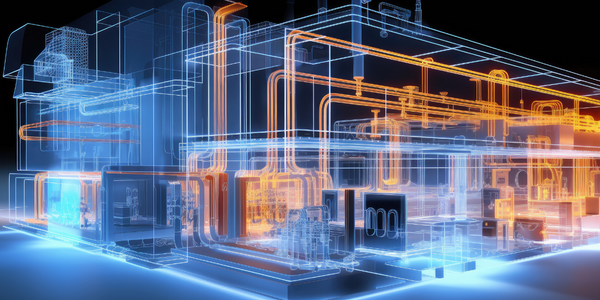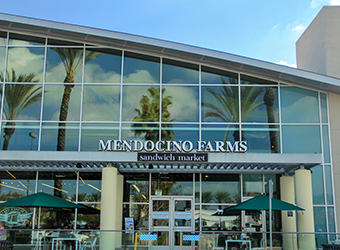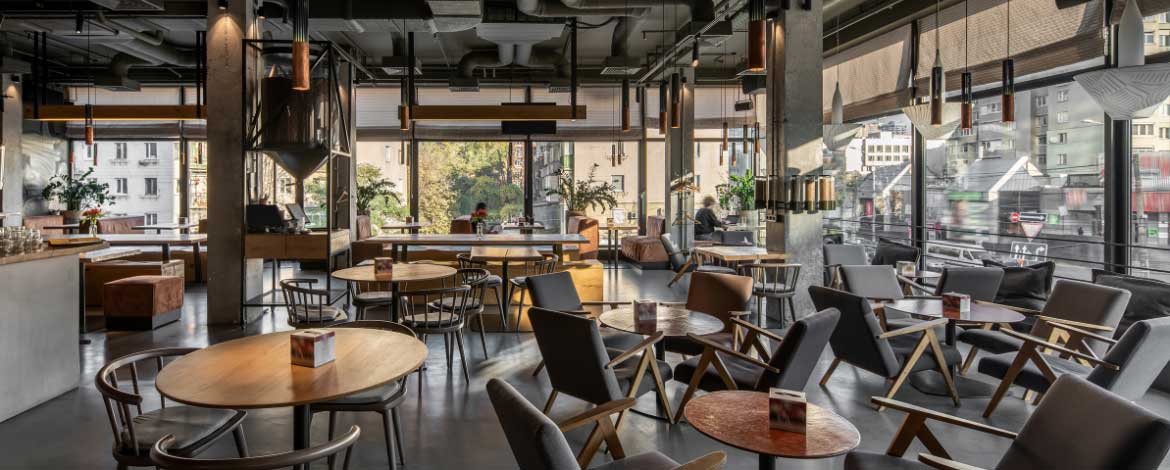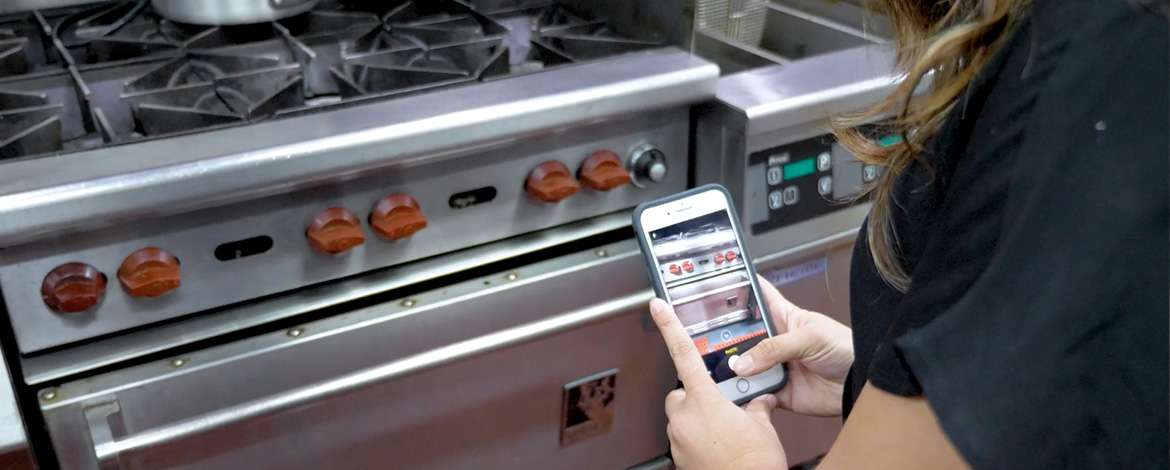Welcome to the future of facility management! As a dedicated facility manager, you know that staying ahead of the curve is key to success. In the digital age, embracing automation and AI is no longer a luxury – it's a necessity. Let's explore how integrating advanced technologies like CMMS platforms, IoT sensors, and robots can revolutionize your facility management practices and take them to new heights.
Embrace the Power of CMMS Platforms
Streamlined Workflows: Bid farewell to manual processes and paperwork. With a robust CMMS platform, you can digitize work orders, track maintenance schedules, and manage assets effortlessly. Save time and stay organized.
Data-Driven Insights: CMMS platforms offer valuable data insights to make informed decisions. Leverage real-time reports and trends to optimize maintenance strategies and boost efficiency.
Optimized Resource Allocation: Allocate resources smartly with predictive maintenance capabilities. Identify potential issues before they escalate, saving costs and minimizing downtime.
Harness the Potential of IoT Sensors
Real-Time Monitoring: Equip your facility with IoT sensors to monitor critical systems in real-time. You'll have a comprehensive view of your facility's performance from temperature and humidity to energy usage.
Proactive Maintenance: Detect anomalies early and address them proactively. IoT sensors can identify equipment issues, preventing breakdowns and costly repairs.
Enhanced Safety: Create a safer environment with IoT sensors that monitor hazardous areas and alert your team to potential risks. Safety first, always!

Embrace the Robot Revolution
Efficient Cleaning and Maintenance: Robots can take over repetitive tasks like cleaning and maintenance, freeing up your team for more strategic projects.
24/7 Operations: Some robots can work around the clock, ensuring continuous monitoring and efficient operations, even during off-hours.
Augmented Workforce: Robots and humans make a powerful team. Embrace robots as valuable allies that complement your team's skills and enhance productivity.

Overcoming Challenges and Embracing Change
Training and Adoption: Empower your team with training on the new technologies. Address any concerns they might have and highlight the benefits of automation and AI.
Data Security and Integration: Ensure robust data security protocols when implementing new technologies. Also, focus on seamless integration with your existing systems for smooth operations.
Flexibility and Scalability: Choose technologies that can adapt to your facility's evolving needs and accommodate future growth.
Conclusion
The digital age presents a sea of opportunities for facility managers to excel. By embracing automation and AI through CMMS platforms, IoT sensors, and robots, you'll not only streamline operations but also enhance efficiency, safety, and resource allocation. Embrace the future with open arms, and witness your facility management practices soar to unprecedented heights.
INDUSTRY INSIGHT
What's Happening at Ecotrak
Heraclitus, an ancient Greek philosopher, is attributed the oft-quoted “change is the only constant in life.”
For many in facilities management, that insight has never felt more relevant. Facilities managers and operators are facing new challenges and economic forces, and change seems to be the only certain thing the industry can rely on.
One thing you can be sure of is that your restaurant will continue to need to maintain and repair equipment to stay in business. However, you may need to revisit your “business as usual” approach to labor, equipment, and managing facilities.
Operators are facing major challenges in two areas: labor (both in-house and with vendors) and supply chain issues (both for new equipment and for parts). Here, we’ll cover tips to help manage facilities and construction during periods of uncertainty. Adopting a new Computerized Maintenance Management Systems (CMMS) facility strategy may help you find new solutions for labor and facilities management challenges.
Uncertainty #1: Labor Challenges
As most operators will tell you, demand is trending high. Organizations are facing an increase in sales concurrent with a general decrease in available labor. Facility managers are facing higher turnover, reduced availability, and potentially less experienced staff — both internally and with vendors.

Labor Within Your Organization
Much of the labor crunch is affecting entry-level roles. For example, as a restaurant operator you may not have enough servers or cooks to fill out the everyday schedule. Or, you may have noticed a decrease in the experience levels of potential employees, as people trained in the industry move to different verticals. These challenges can take from your managers time, forcing them to spend their time focused on day-to-day functions of the facility rather than managing strategically at a high level.
When it comes to managing facilities, busy operators need a tool to help them efficiently manage maintenance of equipment. Facilities management is a high priority, your operators need to be able to rely on their partnerships with service providers, and yet your management may no longer have the time to call, vet, and follow up with vendors.
Your Service Providers’ Labor Challenges
Service providers are facing the same labor shortage issues that facility managers are, particularly as technician demographics indicate an aging workforce without the same number of new workers. With labor as a challenge, many service providers may be resorting to the 80/20 rule (80% of profit is coming from 20% of customers). To cope with labor shortages, some vendors may not prioritize new customers or existing clients that aren’t in the top 20% of their business.
Addressing Labor Challenges with a Facilities Management Solution and Strong Service Provider Relationships
First, if your facility managers are spread too thin, a CMMS can empower your team to tackle more than ever. A CMMS solution can streamline connecting with service providers and automatically provide all the details that they’ll need (make, model number, maintenance history, etc). Your team can tackle challenges successfully, reduce time on the phone, and increase repair accuracy. They can also use the CMMS platform to track costs, invoice status, and spending in real-time.
Second, a CMMS platform can provide not only streamlined communication, but also help you strengthen your service provider partnerships as well. A CMMS solution like Ecotrak has long-standing relationships with service providers that can help bridge a new relationship between your business and vendors.Ecotrak maintains a vetted group of vendors on our system that each have been invited by a fellow industry professional. Ecotrak also now offers a service provider directly that provides access to vendor names. The directory includes performance indicators, such as time to accept, time to arrive, time to complete, and cost of invoice, allowing you to enter a relationship with a new service provider based on measurable outcomes.
Uncertainty #2: Supply Chain Disruptions For Equipment and Parts
After a few years of unprecedented global complexities, the supply chain for facilities is also facing new challenges in two areas in particular: limitations on equipment manufacturing capability and a shortage of parts.

Delays in Equipment Manufacturing & Shortage of Parts
Global challenges to the supply chain, the rising cost of raw materials, and complicated shipping logistics have roiled the facility equipment industry. Many major manufacturers now are facing a timeline of at least 18 months for production of new equipment.
For an operator, this delayed timeline is changing the standard calculation of repair vs replace. Maybe you planned to replace ovens when they hit 10 years old. Unless your organization is proactively planning equipment orders, you may face major delays with your planned timeline and have to pour money into an asset that should have been already off your books.
For similar reasons, facility operators and service providers are also finding a shortage of parts for equipment. Without planning in advance for replacements, you may lose the functionality of a critical piece of equipment for a relatively small part.
Generally, there aren’t a lot of proactive programs to plan effectively to manage your asset base. But in today’s economy and labor market, it will be difficult for your facility to be efficient and effective without functioning equipment.
Asset-First Philosophy to Face Supply Chain Challenges
To address some of these challenges, a CMMS solution like Ecotrak can facilitate an asset-first philosophy to your asset management program.
What might an asset-first philosophy look like in facilities management?
1. Understanding your most vital pieces of equipment
2. Identifying if there is a common failure or replacement part you may want to stock for your facility “crash kits”
3. Tracking the retirement age of equipment so you can plan very far head for proactive replacement
4. Creating a strong maintenance program to keep your priority equipment running
Let’s go over each of these ideas in detail.
#1 - Understanding your most vital pieces of equipment
Many facilities in today’s economy don’t have redundancy built into them. Think about the most critical piece of equipment that you have — if it goes offline, can you deliver to your customers?
A CMMS can help you track data about your vital equipment. When your asset inventory is cataloged in your CMMS, you have the make, model, serial number, and any warranties centralized on one system. A work order runs through all related data points to check for warranty, and information is automatically sent to the service provider with the work order (particularly helpful if service is also experiencing high turnover or has new employees).
#2 - Identifying if there is a common failure or replacement part you may want to stock for your facility “crash kits”
You don’t want to lose sales because you are waiting for a $20 part for your most critical piece of equipment.
A solution like Ecotrak can help you identify the most common failed parts for your equipment (across your facilities or, with advanced systems, aggregated across a larger data set). When a service provider invoices, they log any parts they replaced. With this data, you can create crash kits for your facilities that contain the most critical, core component parts for your vital equipment.
Now that you’ve supplied your own parts, you can focus on the service provider relationship (and also potentially cut down on service overhead).
#3 - Tracking the retirement age of equipment so you can plan very far ahead for proactive replacement
To address manufacturing delays, operators may need to place a higher emphasis on proactive equipment maintenance. It can be beneficial to pull reports on which equipment is outside useful life, where repair and maintenance dollars are going, and the level of effectiveness of your contracted maintenance. With a consolidated list for your financial planning, facility leadership can make strategic decisions on a long-term, proactive timeline.
#4 - Creating a strong maintenance program to keep your priority equipment running
Your CMMS can be used to track the age of your equipment and assets that have depreciated based on industry standards or your company’s accounting practices. The machine learning of a CMMS solution can even help you build analytical models for when your equipment needs to be repaired or replaced. Prioritizing maintenance can help you optimize the life cycle and input cost over your equipment lifetime.
If uncertainties shift further and sales decline, generally the first thing operators pull back on the maintenance program, grabbing money out of the Repairs & Maintenance (R&M) line because it connects straight to the bottom line. However, there is a repercussion for altering an important part of the budget. You may start to see earlier equipment failures, or higher dollars to perform essential maintenance.
If you do need to limit maintenance dollars, you should measure the effects to understand how it may catch up to the business. Will you create a higher capital budget in two years? Can you measure the effectiveness of your R&M in different locations that cut back differently? Understanding these questions can help inform your overall business strategy.
Your Business Can Adapt to Uncertain Times
Your facilities business may be undergoing new tests, but you have the tools and experience to make changes to grow and thrive. With an understanding of industry trends, tools like a robust CMMS, and the expertise of your team, you can face any new challenge coming your way.
Ecotrak Facility Management is the most comprehensive cloud based software platform that manages all key performance indicators in the facilities profession. The solution offers an asset management program that produces work orders, tracks and executes warranties, and has a robust reporting platform. Sign up for a personalized demo of Ecotrak.
INDUSTRY INSIGHT
What's Happening at Ecotrak
It happens at home, just like it happens on the job. You take the time to research appliances, shop around for the best rate, set up your kitchen just the way you like — all in time for something to break down without warning. But while at home you might be able to scrape by without a stovetop for a few days, when it comes to work, inability to function means inability to serve, which means inability to open your doors.
Asset lifecycle management brings predictability to the unpredictable. It allows you to maximize your investment, minimize time spent grappling with adversity, and utilizes the latest in metrics and data analysis to help you learn how you can get even more value out of your appliances.
If you have a good asset lifecycle management plan in place, the three factors listed below are friendly, not fearsome. If you don’t, well, you’re operating like a chef with both hands tied behind his back.
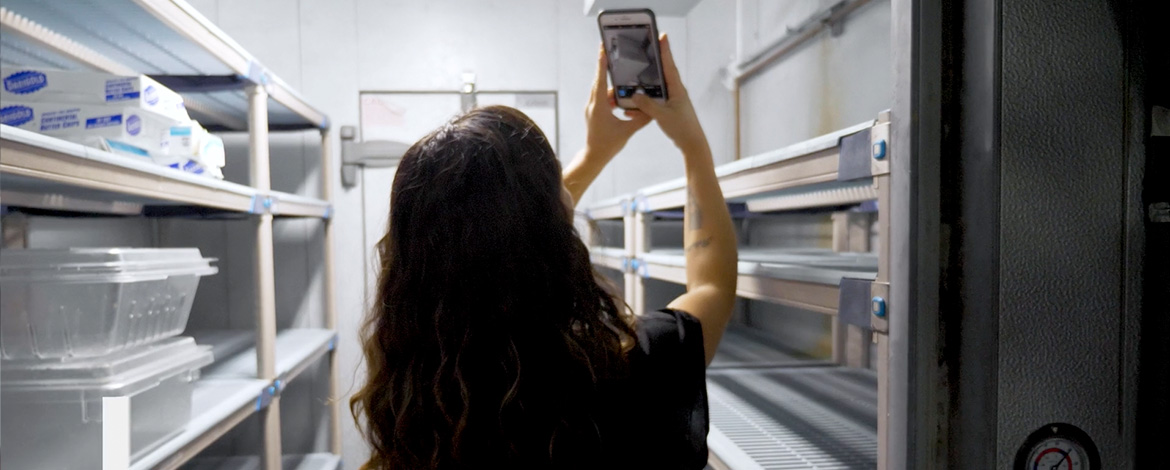
Knowing what the future holds
Every asset has a natural, four-stage lifecycle: Planning, Procurement, Operation/Maintenance and Disposal. Whether your restaurant’s kitchen is shiny and new, or you’re acquiring equipment that already has a few years on the odometer, each item is at some stage of this lifecycle.
If you’re in the early days of a small operation, you might be able to keep track in your head of what’s new, what’s old, and what’s being held together with duct tape. But when your business becomes multiple locations, with multiple kitchens, and you’re making significant investments in ovens, deep fryers, refrigeration, beverage dispensers and more, it can very quickly overwhelm any facilities management team.
A smart business has the foresight to consider the entire lifecycle before even moving beyond the planning phase. As you’re researching manufactures and considering which model is right for your needs, you should also be analyzing likely maintenance costs, the average lifespan of the asset, and what kind of daily wear-and-tear it will endure in your kitchen. As you move into procurement, it’s vital that you activate and track all warranties, have serial numbers and model identifiers at the ready, and that each asset is installed and powered properly. Then, as you move into the operation and maintenance stage, issues can be overcome quickly and efficiently — with information at your fingertips that will prevent duplicate service calls and costly ignorance of the asset’s warranty eligibility.
By predicting when an asset will reach its optimal peak performance and leaning into that window, you can calculate its depreciation value, ensure compliance with regulatory standards and most importantly, keep your business up and running.
Planning a repair and replacement budget
Unfortunately, breakdowns are every bit as unavoidable as death and taxes. At that point, a key question presents itself: Is it worthwhile to repair the asset? Or is it time for disposal and replacement?
This is one moment where, if you have good asset management software to back you up, you’ll be empowered to turn a crucial decision into an educated one. For starters, every breakdown is a learning opportunity. A CMMS platform should compile and analyze them, across all your locations, so you can answer questions like: What’s my most commonly-occurring problem? What’s my most expensive problem? Is one manufacturer brand outperforming another?
If you have Ecotrak as your facilities management software solution, it’s simply a matter of any authorized person in your company taking out their phone, opening the app and looking under Ecotrak’s proprietary “Decision Making Tool,” designed by restaurant and finance veterans with such a moment in mind. The tool displays personalized details about your asset, its original value and likely cost of a replacement. It also offers an estimated useful window of service (based on the hive-mind experiences of other users) and reminds you where yours is in that likely lifespan.
The “Decision Making Tool" or DMT — whose icon is a weight-balance scale, to underscore the plus/minus decision being weighed — then gives you a likely estimate for your repair, shows you how much you’ve spent already over the lifetime of the appliance, and offers an easy-to-read gauge system to make the choice even more transparent. If the needle is in the red, it’s likely time to replace; if you’re in the green, a repair is the more reasonable choice. But perhaps most helpful is the small yellow section, indicating that while you’re safe for now, it would be wise to begin setting aside funds for a replacement in the near future.
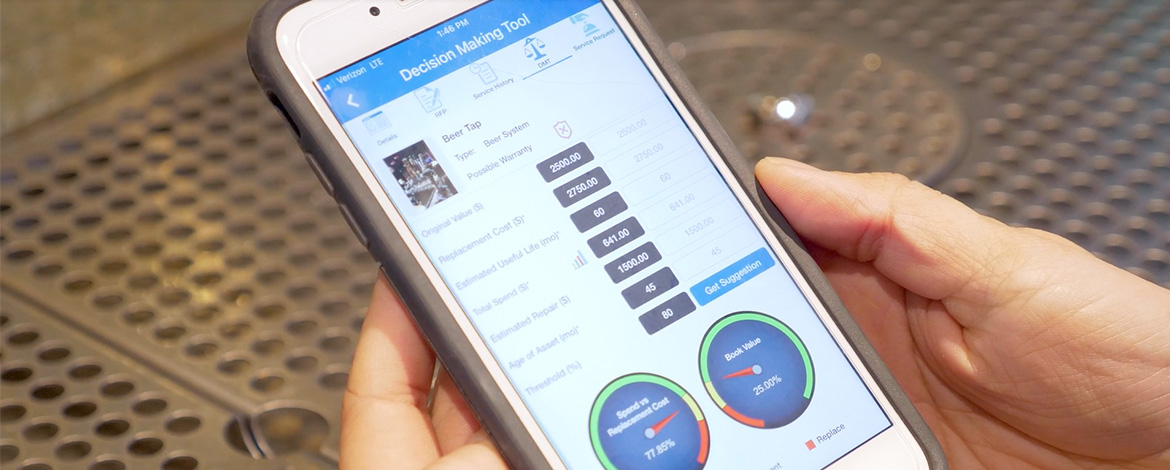
Facility management dependence
Whether you have dozens of locations, or simply dream of getting there someday, it is crucial that you monitor the lifecycles of your assets.
Ecotrak maintains information specific to the asset, then makes it available to both the customer and the service provider, enabling a smoother interaction. From manufacturer to model to serial number, to the ability to track warranties on three different levels (manufacturer, service provider and the often-overlooked component warranties), to documentation and saved photos of the actual equipment, everything is available on the app with a few swipes of a finger.
Another great tool is the custom flagging feature. Imagine if you or your management team could run a report for a designation such as “earmarked for replacement,” immediately pulling up every asset in your company approaching that final stage of the lifecycle. Keep in mind, this is real time information, provided up-to-the-minute by those you have designated at various locations. If a manager came in to find a broken dishwasher during the morning shift today, that could be on your report. This flag feature allows you to build your budget, anticipate work to come, and increase visibility and communication — and keep in mind, you can make as many flags as you need for subheadings like “inspection needed,” “ready to be cleaned” and more.
All this asset lifecycle information, of course, informs your company’s facility management efforts, and vice versa. With a company like Ecotrak, it’s all under one convenient umbrella, constantly updating data that you can view, adjust and share from your mobile device or desktop. So, if you want to see the problems costing the most money across your company, or the ones occurring most frequently, you can do so with precision; if you’d like to view your company’s spend by asset (who knew that maintaining the soft serve machine and grease trap costs as much as the HVAC?), or monitor which vendors are taking the most average days to complete a work order, all that information is similarly up-to-the-minute and ready for a deep-dive analysis.
The bottom line
When it comes to asset lifecycle management, you can either be driving the train or, if you’re not careful, get run over by it. Imagine all the considerations listed above, multiplied by a dozen locations — or a hundred, or a thousand. Whether you’re talking about Del Taco managing 300 corporate locations with their Ecotrak software, or other existing partners like Outback, Burger King and Lazy Dog, it’s easy to see why a software solution for overseeing your assets is a no-brainer.
